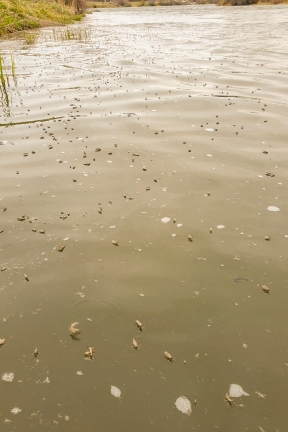
Salmonflies
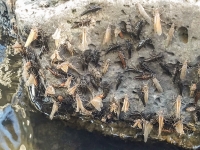
I always like to try to pick the exact day when the big nymphs start to emerge at the Vernon Bridge below Ashton. Last year I predicted May 19th as the date. I was a couple of days off. I missed it because our anticipated runoff, which was above normal May 1st, dropped substantially by May 15th. Average flow at Ashton on May 15th is roughly 2500 cfs. The actual flow was less than 2000 cfs. This can make a big difference in when the big bugs emerge and also what the fishing will be like.
For this year we can start with what we know. Island Park Reservoir is currently just under 122,000 acre feet, slightly above where it was at this time last year. Our snowpack is less than 80% of normal. Last year it was slightly above normal as of this date. What we don’t know is what the weather will be like between now and mid-May. If the weather stays cool we won’t lose our snowpack as quickly. However, a week of above normal temperatures will change things dramatically. That’s what happened last year. When we consider these factors I believe the salmonfly hatch will occur earlier than normal. My prediction is the big bugs will start to crawl at Vernon Bridge on May 14th this year.
For more on salmonflies check out my blog of April 24, 2020.
Blue Winged Olives
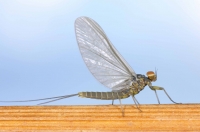
The salmonfly hatch grabs all of the attention with our early season fishing. If you hit it right there is nothing like it. However, it is very difficult to hit it right. There are other early season aquatic insect hatches that are much more predictable. Virtually all of our western rivers get hatches of Baetis, commonly called Blue Winged Olives from late March through mid-May. It’s always heartening to see trout feeding on the first hatches of mayflies of the season.
These gray olive mayflies are multi-brood. The same specie emerge in the spring and autumn. The duns have two tails and a small secondary wing. They are a solid size 18 but I usually get by with a size 16. You’ll need some emerger, cripple and dun patterns. One unique characteristic of this mayfly is that after molting the spinners crawl into the water to deposit their eggs. Both females and males have been observed in this behavior.
You’ll see the most prolific activity when the weather is cool and cloudy. Access can be limited because of snow but you’ll find good Baetis fishing on the upper Henry’s Fork above Mack’s Inn, Last Chance Run, and Warm River to Ashton. The tailwater stretch from the Ashton Dam to St. Anthony also provides a great dry fly fishing opportunity. The Teton River, the South Fork and the Madison also have good Baetis hatches.
Mother's Day Caddis
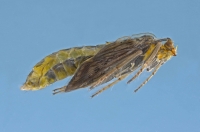
Our first caddisfly hatches should start showing up anytime. They can be prolific. The specie is Brachycentris occidentalis, commonly called the Grannom or Mother’s Day Caddis. The larva is a case maker, the pupa is olive green, and the adult is has gray wings and legs and a gray olive body. It can be best matched in size 16. Best patterns are Olive Partridge Caddis Emerger, Olive Partridge Caddis, Hemingway Caddis, and Olive EZ Caddis. Rather than rewrite what I have already written I encourage you to check out my blog of May 3, 2017.
The quality of fishing this hatch is usually determined by water conditions. Wet years with above normal snowpack usually result in higher flows from the reservoirs to make room for snow runoff. Sometimes it renders the lower rivers too high and off-color for good dry fly fishing. Our water conditions this year may not be optimum for our salmonfly hatch but our Mother’s Day Caddis hatch could be off the charts. I doubt they will be releasing too much water over the next few weeks. I like the Henry’s Fork above and below Ashton for the best caddisfly hatches. The South Fork and the Madison can also be good. When it’s right, it is one of the best dry fly fishing opportunities of the year. We expect these important caddisflies to get going over the next few days. I think it will be great this year.
Western March Brown
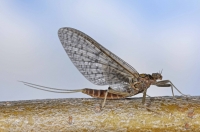
This big mayfly really isn’t a true March Brown. It’s more like the eastern Quill Gordon. The duns are a solid size 14 and you can often get by using a size 12. They are very dark with heavily veined wings. They are more dark gray olive than brown. In spite of their large size trout often seem indifferent to them. I’ve seen them emerge in good numbers on the lower Henry’s Fork along with Baetis mayflies and Mother’s Day Caddisflies. I think one reason trout don’t seem to get overly excited about the duns is because they usually break free from the nymphal shuck under the surface offering a great opportunity to trout. That’s why I always carry a few dark soft hackles and emergers. I like to use them as a dropper about 18” below a dry fly or I swing them as a soft hackle. For more information on this and other hatches check out the hatch chart on our website.
I really enjoy dry fly fishing from now until about the middle of May when things heat up with the salmonflies. It isn’t that I don’t enjoy fishing the big dry flies as much as the next guy, it’s just that there are really a lot of “next guys.” Combat fishing isn’t my game and sometimes the river gets so busy that it isn’t very enjoyable. I’d rather take advantage of these other very important hatches that will provide quality dry fly fishing over the next month.